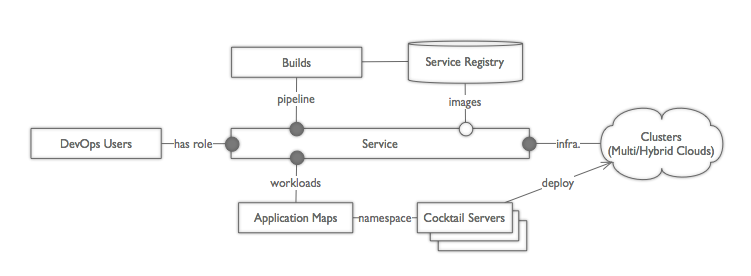Service Management Layer
In general, a single application or service consists of multiple containers. In particular, an orchestration engine such as Kubernetes requires additional objects such as a service port, controller, and storage volume in addition to the container. Therefore, to manage container-based applications and services, an abstraction unit is required to package and manage containers and associated objects. The service management layer fulfills this role.
Cocktail Cloud's service management layer has the following hierarchical structure:
Service : Being the highest level, this group allocates and manages cluster resources, image registries, and image builds required for a service. Independent management is possible through the granting of usage privileges according to developer and administrator roles. In Cocktail Cloud, multiple services can be created as needed and assigned/managed by a team or service.
Application Map : This unit configures/manages applications and corresponds to one workload. For example, a service can be configured via an application map that corresponds to development, validation, and operating systems, and the application map can be configured based on roles, such as data management and analysis systems. Logically, an application map can be considered a unit that manages multiple container configurations for workloads. The previously-described service consists of one or more application maps.
Cocktail Server : This unit packages containers and associated orchestration objects. An application map consists of one or more Cocktail servers. For example, a server can be configured based on components such as web and DB servers, and small-scale microservices can also be configured via a Cocktail server. Cocktail servers are described in detail in the following section.
The following diagram shows how the service management layer is structured:

Cocktail Server
A Cocktail server has the most important role in the service management layer. As previously described, a Cocktail server is a unit for packaging containers and associated orchestration objects. A Cocktail server manages the lifecycle (creation, update, etc.) of a packaged object and monitors and manages the status and resources in package units.
The following diagram describes this relationship:

The management features provided via a Cocktail server are as follows:
Server creation, modification (update), termination, restart, deletion, auto-scaling
Rolling update
Service port management
Volume management
Monitoring
Inspection : Orchestration object status and deployment info lookup
Web terminal and log lookup : Container shell access; Container log lookup
Previous Topic : Cluster Management Layer
Next Topic : Pipeline Layer